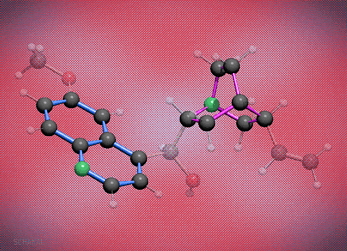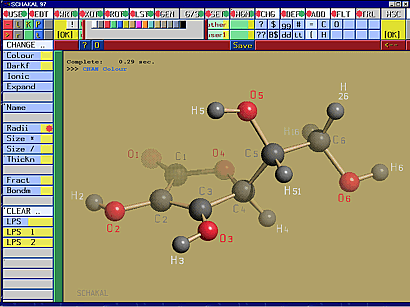Model types
- Wire model
- Ball-and-stick model; space-filling model
- Intersection trace between space filling model and plane
- Intact unique molecules or packing diagrams (with or without H
bonds) from crystallographic data
- Box-like or polyhedrally shaped models from cryst. data
- Spherical or (hkl) surface models from cryst. data
- Automatic generation of bonds and specific drawing parameters for
the individual types of atoms
|
Display styles
- Outlines; Hatching by parallels, meridians, or grids
- Shading by randomly or regularly dithered dots; "realistic"
multi-colour shading with shadows and highlights
- Pseudo-"Cloud" representation (simple) of atoms/bonds
- Optional perspective projections
- Optional stereo drawings with stereo shading/labelling.
- Optionally depth-dependent line thickness, darkness, and/or
pseudo-transparency.
- Fourier backgrounds
|
Rotations
- !+ On-screen rotations including zoom and pan functions for
wire, ball-and-stick and space-filling models.
- Alignment of a least-squares plane/line or of crystallographic
vectors (mostly not on-screen !).
- Optional rotations (or translations) of parts of the model,
e.g., rotation of substituents about bonds (not on-screen).
|
Labelling
- Facility to label atoms automatically with "names", element
symbols, or coordinates (simple line-style characters, but with
adjustable size, boldness, and slantedness).
- Label positions are optimized for minimal overlap. Labels may
be positioned inside and/or outside the atom circles.
- Facility to modify label positions via the mouse.
|
Information
Facility to get information on ...
- Atoms and bonds
- Model statistics
- distances, angles, and torsion angles
- steric trouble
- Current switch and parameter settings
- view direction
|
Structure data Input
- Cell parameters; atom names and coordinates
- Space group symbol (conventional or non-conventional)
or single symmetry operations
- Input defining a parallelepipedal or polyhedral section of
a crystal structure or a (hkl) "surface model".
- + Optional translation of SHELX, CSD, ICSD, PDB, and CIF data
|
Program control
- + "Home-made" GUI (see image below). The GUI generates ...
- Simple commands which allow to select individual (or various
groups of) atoms/bonds.
- Facility to select atoms or bonds by the mouse or by means
of an irregular polygon drawn around them.
- Various "distributed command files" for routine tasks
- Facility to generate command files by recording user input.
- Facility to edit structural data and command files "on-line"
- Detailed on-line help functions;
- Interactive manual surfable with the mouse (no Hypertext !)
|
Graphical Output devices
- 256 colours or black-white [B/W] screen drawings
- TIFF/.pcx file with up to 4 x the (linear) screen resolution
- 6-8 colours or B/W HP-GL file (for HP plotter or text proc.)
- B/W HP LaserJet 3 - 6 (or fully compatible), 150 - 600 dpi
- 256 colours or B/W HP-GL/2 file (for certain HP printers)
- 256 colours or B/W Postscript/EPS
- 256 colours or B/W Windows Metafile (very large files)
- 256 colours or B/W Windows printer (only under MS-Win)
|
Versions
- MS-Win version (A version) (Win9x/ME/NT/2K/XP).
Capacity: 40000 atoms and bonds. The Win version is
significantly less easy to use than other Win
applications (due to the different GUI, see image below).
- UNIX/X-Windows version (B version).
Capacity: 40000 atoms/bonds.
The UNIX version is known to run under ...
Irix 5.3 to 6.5;
Solaris 2.5.1;
Dec-OSF1 (DEC Alpha);
Aix 3.5/4.2;
HP-UX 9/10;
Linux.
|
Extent of supply
SCHAKAL 99 consists of the following items:
- the executable programs (MS-Windows version only)
- the FORTRAN / C source code of about 45000 lines (UNIX
version only); FORTRAN 77 and ANSI C compiler required.
- an interactive hierarchical on-line manual in English
(about 330 pages, if printed); note: a Tutorial Manual
may be donwloaded from the DOWNLOAD section of this site (see bottom).
- a program to make a printout of this manual
- a space group database; some data set examples
- a number of "distributed command files" for routine tasks
- installation program and makefile (UNIX versions)
|

